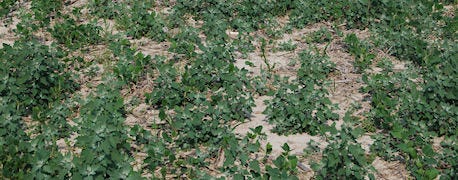
Unless you're planting double-crop soybeans or replanting soybeans that died after trying to sprout in semi-dry dirt, or replanting because slugs ate up your beans in south-central Indiana, you may read this item more to understand why your lanmbsqaurters and marestail were especially hard to control this year than to do anything about helping this year's crop. There's always next year's crop you can concentrate on.

Time to pray! – These lambsquarters would be extremely tough to bring down now under drought conditions, Bill Johnson says.
Bill Johnson, Purdue University weed control specialist, says that farmers reported difficulty in bringing down lambsquarters and marestail in many situations in soybeans. Once they get any size, say 4 inches or more, and especially if they're stressed by drought, they're extremely tough to control, he says.
"And if they're bigger than 4 inches tall, all bets are off," Johnson says. These become very hard weds to handle."
One of Johnson's favorite comments when asked about an impossible situation si to answer that you better pray hard. A field with tall lambsquarters and marestail would fall into that category.
If you have fields that still fall into the category where you believe you can control these weeds, then give it your best shot, he says. Use the maximum rate. Check the label to see if the manufacturer calls for adding Nitrogen or a special adjuvant package if you are spraying in stressful conditions. You'e going to need to heat up the mixture to have any shot at controlling weeds once they get a head start and have that much size, he notes.
Johnson made these comments as part of a Purdue University conference call designed to inform Extension educators across the state about how to advise farmers with questions related to surviving the dry weather. Some areas of Indiana are already classified by the U.S. Drought Monitor as being in a drought category. Other areas are abnormally dry. Weed control is much tougher once weeds harden off in dry weather, Johnson concludes.
About the Author(s)
You May Also Like




